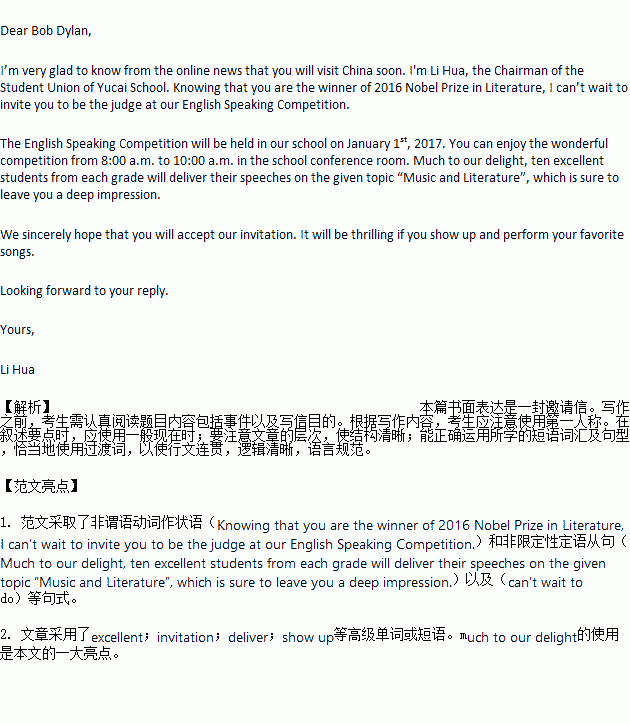��Ŀ����
������������ѧУ��ѧ������ϯ��������ŵ�֪2016��ŵ������ѧ������Bob DylanҪ���й�������ѧУ����2017��3��6������1:00��3:00��ѧУ�������ٰ�һ������Ϊ����������ѧ����Ӣ���ݽ����������Ը����꼶��ʮλ����ѧ������������������ѧУѧ����дһ������ʼ���������������ί��
ע�⣺1.���¿�ͷ�Ѹ������������ܴ�����
2. ���ʵ�����ϸ�ڣ�ʹ�������ݳ�ʵ�����ᡣ
3. ������100�����ҡ�
��ʾ�ʣ�ŵ������ѧ�� Nobel Prize in Literature ������ conference room
 �Ķ��쳵ϵ�д�
�Ķ��쳵ϵ�д�Passage 3��2017�콭��ʡ�ϸ߶��и�������
��� | ���� | ���� | �Ѷ� | ��ȷ�� |
˵���� | Jake Beckman����������Ӧ�Զ��߸��� | 361 | ������ |
The Internet is full of headlines that grab your attention with buzzwords (���д�). But often when we click through, we find the content hardly delivers and it wastes our time. We close the page, feeling we��ve been cheated. These types of headlines are called ��click bait��.
A headline on Businesslnsider.com reads: ��This phrase will make you seem more polite��. First, when you click through, you find another headline: ��Four words to seem more polite.�� Then, on reading the article, you find it��s actually an essay about sympathy. And what are the four words? They��re ��Wow, that sounds hard.�� On some video websites, you might encounter headlines such as ��Here��s what happens when six puppies visited a campus��. Turns out it��s just some uninteresting dog footage (��ͷ).
Nowadays, with the popularity of social media, many news outlets tweet (����) click bait links to their stories. These tweets take advantage of the curiosity gap or attempt to draw the reader into a story using a question in the headline. These click bait headlines are so annoying that someone is attempting to save people time by exposing news outlet click bait through social media. The Twitter account @SavedYouAClick, run by Jake Beckman, is one such example.
Beckman��s method is to grab tweets linking to a story and retweet them with a click-saving comment. For example, CNET tweeted ��So iOS 8 appears to be jailbreakable but...��, with a link to its coverage of Apple��s product announcements. Beckman retweeted it with this comment attached: ��... it hasn��t been jailbroken yet.��
Since founding the account, Beckman��s Twitter experiment has brought him more than 131,000 followers. Beckman said that @SavedYouAClick is����just my way of trying to help the Internet be less terrible.�� Asked about his goal, he said, ��I��d love to see publishers think about the experience of their readers first. I think there��s an enormous opportunity for publishers to provide readers with informative updates that include links so you can click through and read more.
1.The article on Businesslnsider.com turns out to be___________.
A. useful suggestions on politeness
B.an essay about another topic
C.an article hard to understand
D. a link to a video website
2.Why are readers often cheated by tricky headlines?
A. Social media has become more popular.
B. Readers have questions to be solved.
C. Such headlines are fairly attractive.
D. There��re always stories behind them.
3.Beckman attached his comment to CNET��s tweet to __________.
A. criticize CNET B. save readers�� time
C. advertise apple��s new product D. tell readers something about iOS 8
4.In the last paragraph, Beckman appeals that _________.
A. publishers be more responsible for the link
B. readers think about their needs before reading
C. publishers provide more information for readers
D. people work together to make the Internet less terrible
Passage1
��� | ���� | ���� | �Ѷ� | ����ʱ�� |
˵���� | �ɿ�����˾�ķ�չ | 221 | ������ | 5���� |
Given that many people��s moods (����)are regulated by the chemical action of chocolate, it was probably only a matter of time before somebody made the chocolate shop similar to a drug store of Chinese medicine. Looking like a setting from the film Charlie & the Chocolate Factory, Singapore��s Chocolate Research Facility (CRF) has over 100 varieties of chocolates. its founder is Chris Lee who grew up at his parents�� corner store with one hand almost always in the jar of sweets.
If the CRF seems to be a smart idea, that��s because Lee is not merely a seasoned salesperson but also head of a marketing department that has business relations with big names such as Levi��s and Sony. That idea surely results in the imagination at work when it comes to making different flavored(�)chocolates.
The CRF��s produce is ��green��. made within the country and divided into 10 lines, with the Alcohol Series being the most popular. The Exotic Seriesһwith Sichuan pepper, red bean (��).cheese and other flavorsһalso does well and is fun to taste. And for chocolate snobs��who think that they have a better knowledge of chocolate than others, the Connoisseur Series uses cocoa beans from Togo, Cuba, Venezuela , and Ghana, among others.
������1�� What is good about chocolate?
A. It serves as a suitable gift.ѧ.��.��Z.X.X .B. It works as an effective medicine.
C. It helps improve the state of mind. D. It strengthens business relations.
������2�� Why is Chris Lee able to develop his idea of the CRF?
A. He knows the importance of research.
B. He learns form shops of similar types.
C. He has the support of many big names
D. He has a lot of marketing experience.
������3�� Which line of the CRF produce sells best?
A. The Connoisseur Series. B. The Exotic Series.
C. The Alcohol Series. D. The Sichuan Series.

